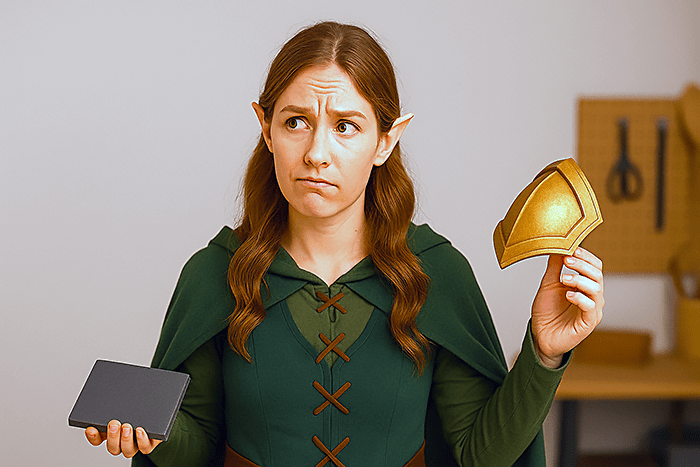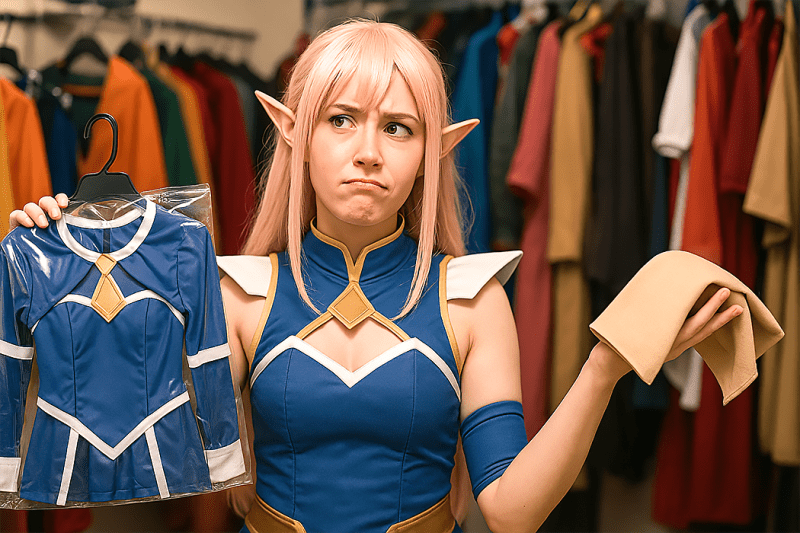Key Takeaways:
- The 2025 Comic-Con Masquerade has a strict July 7 deadline for entries, photos, and soundtrack submissions
- Costumes must feature at least 75% original construction or significant modification to be eligible
- Time limits for performances range from 1:30 minutes for solo presenters to 2:30 minutes for large groups
- Lauren's Mystic Marketplace offers consultation on costume design and specialty materials perfect for creating award-winning masquerade entries
- Having prepared poses, reference materials, and emergency repair supplies can dramatically improve your masquerade experience
Mastering the 2025 Comic-Con Masquerade: What You Must Know
The masquerade ball represents the pinnacle of cosplay artistry at San Diego Comic-Con. It's not just a costume contest – it's a theatrical showcase where creativity, craftsmanship, and performance combine to create memorable moments that celebrate fandom in its most expressive form.
If you're planning to participate in the 2025 Comic-Con Masquerade, preparation begins now. The competition attracts the most dedicated cosplayers who spend months perfecting their entries. Understanding the rules, requirements, and expectations is essential for a successful experience. Lauren's Mystic Marketplace has been supporting cosplayers and costume designers for years, offering costumes and accessories for creating standout pieces that capture judges' attention.
Essential Registration and Eligibility Rules
1. July 7 Deadline: Entry Forms, Photos, and Soundtrack Submissions
Mark your calendar – July 7, 2025, is the absolute deadline for all masquerade submissions. This includes your entry form, reference photos of your costume, and any audio or background images you plan to use during your presentation. Spots fill quickly, often by early June, so submitting early is strongly recommended.
Photos are particularly important as they're required for review to ensure your costume meets the originality requirements. You can submit work-in-progress photos if your costume isn't complete, but they should show that only minor work remains.
2. The 75% Original Construction Requirement
The masquerade celebrates creativity and craftsmanship, not shopping ability. At least 75% of what appears on stage must not have been purchased ready-made. This doesn't mean you personally must have made every element – friends or family can contribute – but commercial sources should be minimal.
This rule exists to maintain the integrity of the competition as a showcase for costume creation rather than costume collection. Judges will expect honesty about which elements were purchased versus handcrafted.
3. When Your Costume Can't Compete
Several scenarios make a costume ineligible:
- If it has previously appeared on the Comic-Con stage
- If it has been openly displayed at the convention before the masquerade
- If it doesn't meet the 75% original construction requirement
Additionally, to preserve the surprise element and keep your costume in perfect condition, you should not wear your contest entry around the convention before Saturday night's competition. This both protects your creation from damage and ensures the audience sees something new and exciting.
Competition Categories That Define Your Entry
1. Re-Creation vs. Original Design
The Comic-Con Masquerade divides entries into two primary design categories, with judging criteria tailored to each:
Re-Creation: These costumes replicate pre-existing designs from movies, TV shows, comic books, video games, artwork, collectible statuettes, toys, or historical references. Judges evaluate how accurately your costume captures the source material's details, proportions, and overall look.
Original Design: These are costumes that you've conceptualized yourself, showing your creative vision rather than copying an existing character. While they may be inspired by fantasy, science fiction, or mythology, they represent your unique interpretation. Judges focus on creativity, innovation, and execution of your original concept.
If you're unsure which category your costume belongs in, don't worry. The judges will determine the appropriate category after examining your work during prejudging.
2. Age Divisions and Young Fan Requirements
The Young Fan category accommodates participants aged 12 through 17, allowing younger cosplayers to showcase their talents. These entries are also classified within one of the main categories (Re-Creation or Original Design) but compete against peers of similar age and experience.
It's important to note that children under 12 cannot participate in the masquerade for safety reasons. The backstage environment and elevated stage present potential hazards that the convention has determined are not appropriate for younger children.
All minors must have a parent or guardian backstage with them and must provide signed permission forms. Additionally, minors are prohibited from performing combat simulations during their presentations.
3. Group Entry Considerations
Group entries create impressive visual impact but come with additional logistics to consider:
- Each person can appear in only one entry, unless their costume transforms on stage
- Coordinating consistent quality across multiple costumes is crucial
- Stage time increases with group size (3-6 people: 2 minutes; 7+ people: 2:30 minutes)
- Choreography becomes more complex and requires additional rehearsal
Groups should designate a leader who coordinates communication with the masquerade staff and ensures all members understand the rules and timing requirements.
Perfecting Your Stage Performance
1. Time Limits Based on Group Size
The masquerade enforces strict time limits to keep the show running smoothly:
- Solo or duo entries (1-2 people): 1 minute 30 seconds
- Small groups (3-6 people): 2 minutes
- Large groups (7 or more people): 2 minutes 30 seconds
These limits aren't targets to fill completely—sometimes a shorter, more impactful presentation leaves a stronger impression. Plan your performance to showcase your costume effectively within the time constraint.
2. Choreographing Effective Poses and Movements
Your time on stage is your opportunity to bring your character to life and showcase your costume's best features. Practice different poses that highlight the details and craftsmanship of your creation. Develop a sequence of movements that feel natural to your character while ensuring the audience can appreciate your work from multiple angles.
For walk-ons, prepare at least three distinct poses and hold each for about five seconds so photographers can capture your costume. For scripted performances, ensure your movements emphasize your costume's special features while advancing your narrative.
3. Technical Elements: Music and Background Images
Music and background images can dramatically enhance your presentation. Submit MP3 or MP4 audio files by July 7, 2025, to masq@comic-con.org. If your presentation includes dialogue, either include it in your pre-recorded track or provide a script for the Master of Ceremonies to read—there won't be microphones for contestants during the show.
For background images, you can provide a JPG or PNG file to create a setting that complements your costume. These images should be scenery or abstract designs only, without copyrighted characters. Images must be submitted by July 7 and should be sized appropriately (no larger than 2048 x 2048 pixels).
4. Forbidden Items That Will Disqualify You
Certain elements are strictly prohibited due to safety concerns or venue policies:
- Liquids, messy substances, smoke, fog, or flame
- Unsheathed bladed weapons (without prior coordinator approval)
- Content that would earn a movie an "R" rating
- Nudity or inappropriate content
- Throwing items into the audience
- Touching the emcee
Violating these rules can result in immediate disqualification and possibly being escorted from the premises. If you're uncertain about any element of your performance, consult with the masquerade coordinator well in advance.
Behind-the-Scenes Preparation
1. Craftsmanship Judging: What Judges Look For
Before you step on stage, you'll participate in craftsmanship judging where experts evaluate the construction quality of your costume. They'll examine your techniques, material choices, attention to detail, and problem-solving creativity.
The judges will want to understand your process, including pattern work, fabric manipulation, armor construction, prop building, or any other techniques you employed. Be prepared to explain your methods and highlight the most challenging aspects you overcame.
2. Creating Winning Reference Materials
Well-prepared reference materials give judges the context they need to appreciate your work. For re-creation costumes, providing clear images of the original design helps judges assess your accuracy. For original designs, concept art and sketches show your creative process and design intent.
The most effective reference materials include:
- Multiple high-quality images of the source character from different angles
- Close-up details of textures, patterns, and accessories
- Progress photos showing key construction stages
- Material samples or swatches if you dyed or treated fabrics
- Brief notes explaining special techniques or challenging elements
Organize these materials in a small binder or folder that's easy for judges to review. Some competitors create detailed "build books" that document their entire process from concept to completion.
3. Day-of Timeline: Check-in Times and Requirements
On Saturday, timing is everything. Here's a breakdown of the critical schedule:
- 10:30 AM: Attend the optional but highly recommended Contestant Orientation in Room 31AB
- Before 11:00 AM: Submit completed show forms at the Masquerade Desk in the Ballroom 20 lobby
- Afternoon: Take advantage of the rehearsal stage in Room 31AB for practice
- 5:00-6:00 PM: Recommended arrival time at the backstage area (Room 32AB)
- 6:45 PM: Absolute deadline for backstage check-in
- 7:00 PM: Be fully dressed and ready for pre-show photos and judging
Missing these deadlines may result in being removed from the lineup, as the show's audio and visuals are programmed before the event begins. The masquerade staff adheres to a strict schedule to ensure the show runs smoothly for all participants.
Emergency Preparedness for Masquerade Success
1. Must-Have Repair Kit Components
Even the most carefully constructed costumes can suffer last-minute malfunctions. Bring a compact repair kit with these essentials:
- Safety pins in various sizes
- Quick-bonding adhesive (like E6000 or hot glue sticks)
- Needle and thread matching your costume colors
- Double-sided fashion tape
- Small scissors
- Clear nail polish (stops runs in fabric and tights)
- Zip ties or wire for structural repairs
- Bobby pins and hair ties for wig emergencies
While the backstage area will have some emergency supplies, having your own kit ensures you have exactly what you need for your specific costume materials. Lauren's Mystic Marketplace offers special accessories to help charge up any costume's elegance!
2. Navigating Backstage Challenges
The backstage environment can be hectic and crowded. Prepare for these challenges by:
- Identifying the nearest restrooms immediately upon arrival
- Locating the private dressing areas and makeup stations
- Finding a safe space to store your personal belongings
- Understanding the traffic flow from preparation area to stage
- Knowing who to ask for help if you need assistance
If your costume has limited mobility or visibility, arrange for a handler to guide you. Some contestants bring a friend specifically to help with last-minute adjustments and navigation.
The 32×20 Stage: Maximizing Your Performance Space
The Ballroom 20 stage offers a generous performance area measuring 32 feet wide by 20 feet deep. At 48 inches high, it provides excellent visibility for the audience but requires navigating stairs to access. Understanding this space helps you plan an effective presentation.
Standard entry is from stage right (your right when facing the audience), with exit on stage left. Groups may enter and exit from both sides for more dynamic presentations. The emcee will be positioned at stage left, while judges will be seated center-front in the audience.
When planning your movement, remember to utilize the downstage area (closest to the audience) for important poses or moments. This positioning ensures the audience and photographers can capture the details of your costume clearly.
Masquerade Etiquette: Supporting Your Fellow Cosplayers
The masquerade community thrives on mutual respect and support. Practice good etiquette by offering genuine compliments to other contestants, refraining from negative comments about others' work, keeping noise levels down in the green room while others are performing, being patient with staff, and celebrating all winners graciously.
Remember that many contestants are nervous; a kind word or offer of assistance can make a significant difference in someone's experience. The masquerade is competitive, but it's primarily a celebration of creativity and shared passion.
Transform Your Comic-Con Experience Through Masquerade Competition
Participating in the Comic-Con Masquerade isn't just about competing for awards—it's about joining a vibrant community of creators who push the boundaries of costume art. Win or lose, the experience offers invaluable growth opportunities through feedback from expert judges, connections with fellow cosplayers, and the thrill of performing for an enthusiastic audience.
The skills you develop—from precision crafting to performance techniques—extend far beyond the convention hall. Many professional costume designers, special effects artists, and performers trace their career beginnings to masquerade competitions.
Whether this is your first masquerade or you're a seasoned competitor, approach the event with a spirit of creativity, excellence, and community. The memories and friendships formed backstage often prove more valuable than any trophy awarded onstage.
For accessories to spice up your design, visit Lauren's Mystic Marketplace.



